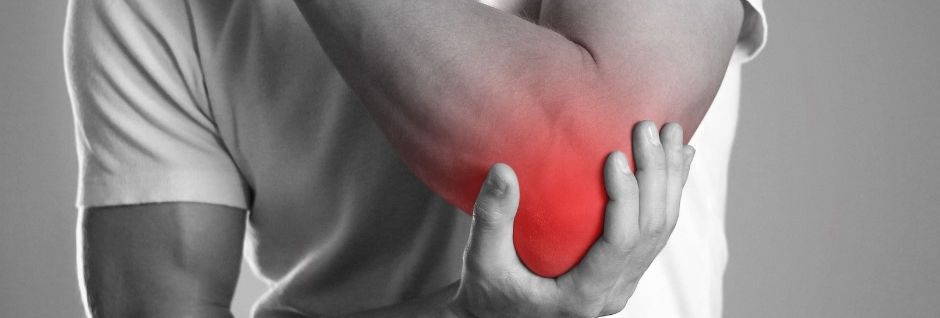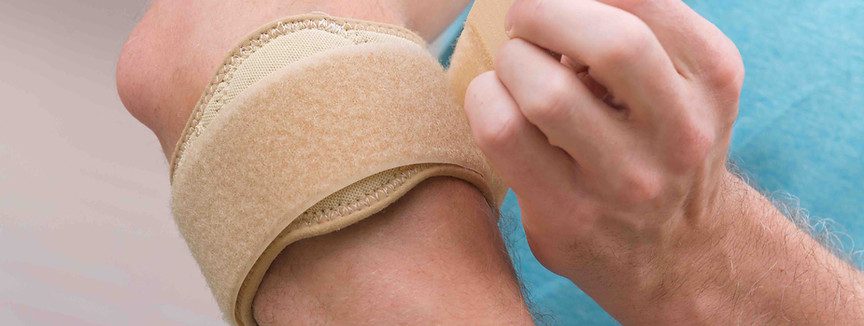Tennis Elbow Treatment

Tennis Elbow is a common chronic condition affecting the outside of the elbow. Between 1-3% of adults in the UK suffer with Tennis elbow and it is most prevalent in those aged between 40 and 50 years of age.
Not to be confused with Golfer’s elbow, Tennis Elbow affects the muscles on the outside of the arm, which is where the muscles that straighten your hand and extend your wrist attach. It is the most common elbow injury, even surpassing that of Golfer’s Elbow.
Tennis Elbow is known medically as Lateral epicondylitis, which means it affects the outside of the elbow, whereas Golfer’s Elbow is known, as Medial epicondylitis affects the inside of the elbow.
Golfer’s elbow tends to affect the muscles that close your hand and flex your wrist.
Why does pain occur in the elbow?

Tennis Elbow affects the muscles that attach onto the outside of the bones in your upper arm.
It is often the result of over using these muscles and causing them to tug on their attachment point, creating inflammation and pain. Over time the tendon starts to get damaged.
This is why it is often seen in people who play tennis, but it can be seen in anyone who overuses the muscles of the forearm, such as hairdressers, desk workers, painters and gardeners.
Treatment

Treatment for Tennis Elbow is complex. Initially there is a need to calm the inflammation and allow the tendon to heal. For this ice works very well as do the elbow straps that can be bought at a local pharmacist.
The straps work by altering the stresses that run through the tendon, allowing them to heal while you continue your work. However, treating the site of pain alone, is not a long term solution to the problem.
As it is a chronic condition, it is important to assess the whole arm line, right up into the neck, to work out where the weaknesses are. If you are a tennis player, we would assess the grip size of your racket, as incorrect sizes can lead to over gripping, and therefore overuse of the forearm muscles.
If you are not a tennis player, we need to understand why you are over using these muscles, so we would assess the whole arm line, and restrengthen and loosen the muscles as needed.,
Strengthening

For a long term solution to this condition it is important to restrengthen not just the wrist but the whole arm.
As the muscles of the forearm get weaker, the muscles of the upper arm will start to assist, and this can lead to the muscles at the front of the chest, such as the pecs, over working.
This, in time, can lead to neck and even nerve issues, so it is important to treat the whole area. We would start by strengthening the muscles that extend your wrist, usually using a light dumbbell.
In addition, we would assess the strength of your upper arm muscles and check that your firing patterns are correct. It is important that all the muscles fire in the right order, to stop compensation occurring.
We would also assess and, if necessary, treat any nerve issues that often accompany this condition. The aim is to get a long term solution to the pain by getting rid of the initial causes.,
Frequently Asked Questions about Tennis Elbow
This condition is rarely isolated to the elbow itself. Usually we need to treat the whole upper arm. It often also includes the nerves, so it can take a while to treat. Usually, however, within around 3 or 4 treatments you should be feeling better and if after 6 treatments you are still in pain we would be looking to arrange a scan or x-ray to confirm the diagnosis.
Tennis Elbow is a caused by chronic inflammation, so the quickest way to relieve the pain is to ice the elbow area for 10 mins every hour.
However, this will just relieve the pain, to fix the problem permanently it will take longer and involves a thorough assessment and rehabilitation process which can take a few months.
For more information, take a look at the NHS website on this here.
Here at The Reinge Clinic it doesn’t matter whihc you see, as our Physiotherapist is also a trained Sports Therapist. If you are a Tennis Player a Sports Therapist will also be able to check things like your Tennis technique, Grip Strength and Muscle Firings, so the problem doesn’t return when you return to a tennis court.
If you aren’t a Tennis Player, it doesn’t matter which you see as both types of therapy will competently assess, treat and rehabilitate the area.
Tennis Elbow is an overuse injury, so if you stop doing the activity that hurts it, the pain will go away. However, once you start the activity again, it will return.
As you will compensate, due to the pain, over time you will start to over recruit other muscles. In time, this may create a problem elsewhere in the body.
It is always best to get an assessment, to confirm it is Tennis Elbow, and get some initial advice. Even if you decide not to complete a full treatment program.
No, unfortunately, as it is an overuse injury of the forearm, you can get it even if you have never played tennis!
Any profession that involves lots of gripping, such as Hairdressers, Electricians and Barbers often get Tennis Elbow.
Learn more about Tennis Elbow
What Our Clients Say About Us?
Francis Butt
September 20, 2022
As always, brilliant evaluation, treatment and strategy. Thanks Ian!
Claire Kelley
October 10, 2022
Ian is brilliant at really working to solve the problem. He doesn't rush to get you back but gives you time for set exercises to work and then reassess. Would definitely recommend
Helen Littlewood
October 19, 2022
Totally looked after by Ian - really reassured that he can help and support me in my goals Thank you
Zoe Statters
October 20, 2022
Always upbeat, friendly, offers useful advice & service is always top notch, suggestions and treatments that actually work!
Matt Morrisey
December 8, 2022
EXCELLENT , HELPED ME UNDERSTAND ALL MY ISSUES AND HOW TO START TO RE AJUST
Sonia Chamberlain
September 5, 2023
Gina is a brilliant therapist! Very friendly, supportive and provides a holistic approach to MSK problems.
Katie Silverthorne
September 5, 2023
Gina is an absolutely marvel! I had incredibly painful and chronic shoulder pain that had been causing serious issue for over 2 years. I had been to lots of different practitioners - with no luck. Happily Gina set me right! I couldn’t be happier. ????
Wynford Dore
September 5, 2023
I needed the pain to go away....yet had discovered in recent years that not all physios are equal! So I put more effort into finding one that was good - and subsequently went to Gina at The Reinge Clinic. Bottom line .... the pain has completely gone - she seemed to know quickly where the root cause of the problem was hiding, and addressed it. Only took 3 sessions - I had expected it to take far longer. Huge thanks.
Sarita Bhardwaj
September 5, 2023
Gina was very informative, patient and she successful in completely eliminating my shoulder and arm problems - Thank you so much!